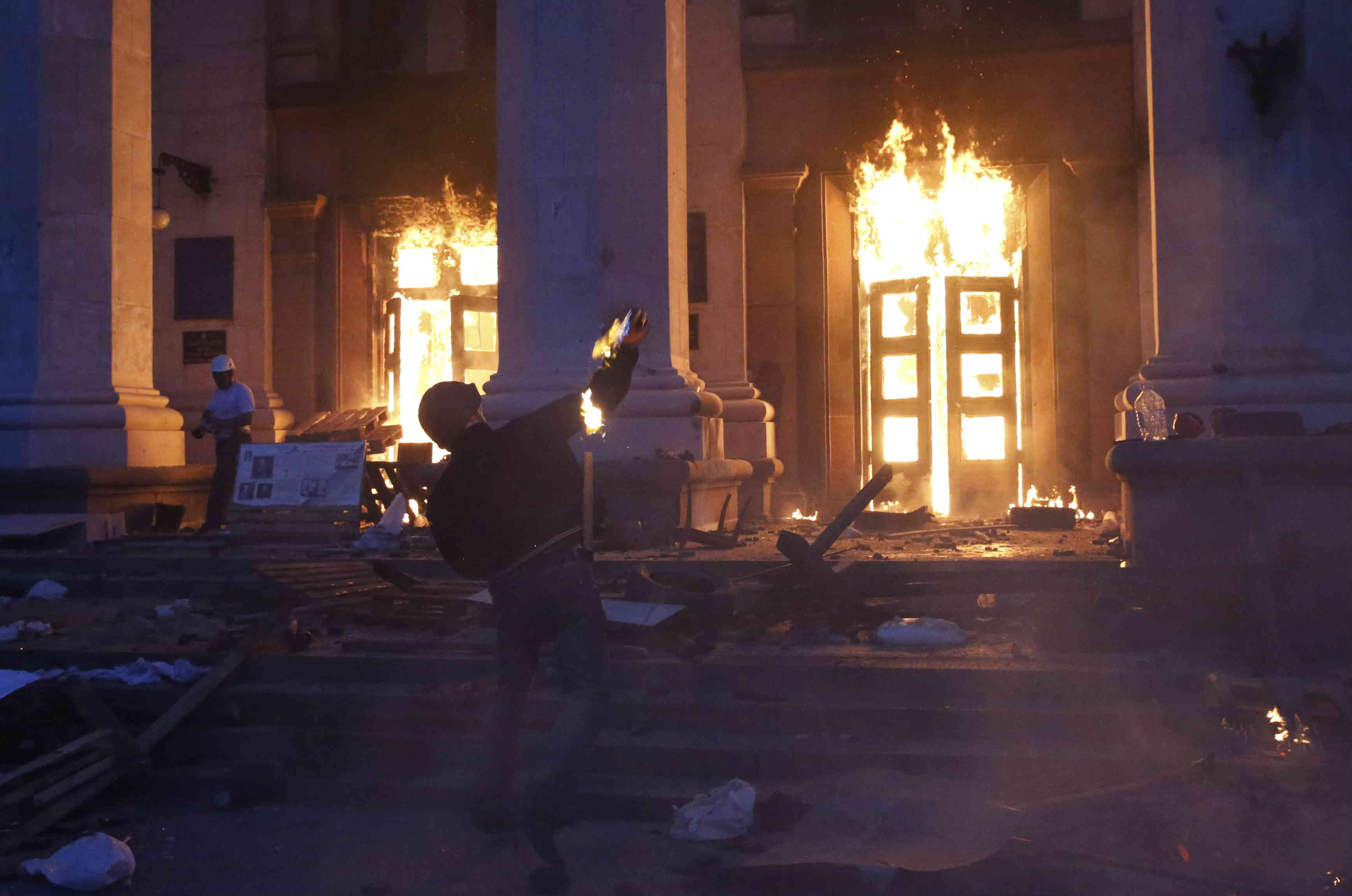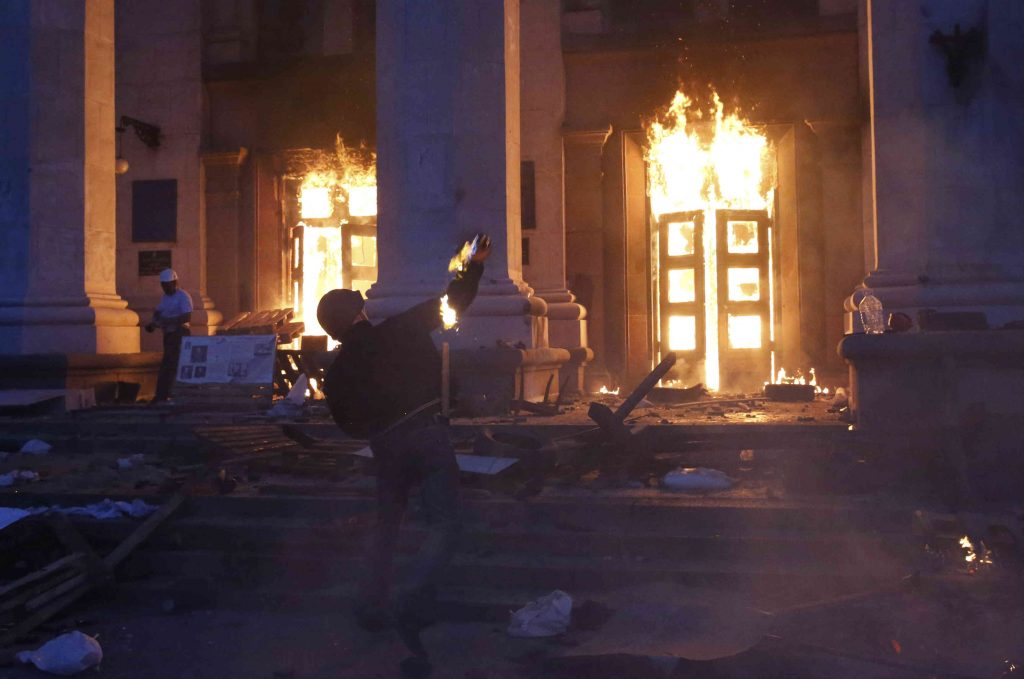 Forty-eight people lost their lives in clashes between pro-unity supporters and pro-Russian backers and a fire in Odesa on May 2, 2014. Only hours later, Russia attempted to portray the mass riots and ensuing fire as a massacre, and that has continued regardless of several investigations, including one by the Council of Europe’s International Advisory Panel.
Forty-eight people lost their lives in clashes between pro-unity supporters and pro-Russian backers and a fire in Odesa on May 2, 2014. Only hours later, Russia attempted to portray the mass riots and ensuing fire as a massacre, and that has continued regardless of several investigations, including one by the Council of Europe’s International Advisory Panel.
It is no accident that many of the young men—both Ukrainian and Russian—who volunteered to fight for Kremlin-backed militants in the Donbas mentioned the events in Odesa as a catalyst. Russia is continuing to use lies about May 2, 2014, as a weapon in its undeclared war against Ukraine, and the death toll is rising.
It’s important to understand what happened in Odesa on May 2. All of the impartial investigations confirm that the clashes were deliberately provoked by a large group of pro-Russian activists who attacked a peaceful march for Ukrainian unity. Weapons and firearms were then used by people on both sides. It is certain that pro-Ukrainian-unity activists who arrived at Kulikovo Pole Square intending to destroy pro-Russian activists’ tents were shot at by activists from inside and on the roof of the Trade Union building. The reports all cite independent experts’ assessments, which conclude that there is no way to determine whether the fire was caused by Molotov cocktails thrown by pro-Russian activists from inside the building, or by pro-unity activists outside the building.
Video and other testimony confirms that the vast majority of people outside had no idea that there were so many people trapped in the building. The frantic efforts by pro-unity activists to save lives are always edited out of Russian and pro-Russian propaganda, but can be seen on countless videos. We know how many people died and why, with the main onus of responsibility lying with the emergency services that took forty minutes to arrive.
None of this suits Russia’s propaganda machine, which has from the outset carefully and deliberately manipulated video footage, and found “witnesses” willing to travel around Europe repeating a different story.
The Council of Europe’s International Advisory Panel issued its report on November 4, 2015. Pro-Kremlin media clearly read it, but repeated only its considerable criticism of Ukrainian authorities over the investigation. Once the publicity over the report had died down, it was business—lies and distortion—as usual.
Although the propaganda is most visible in Russian and pro-Russian media, its scope is much greater as a result of traveling exhibitions, conferences, and publications that clearly receive generous funding from the Kremlin.
One such event took place in Geneva on March 21 under the title “Ukraine: Maïdan, Odesa – Deux ans après.” Such events are increasingly presented as being linked to human rights organizations, but the website of the Human Rights Agency, which convened the event, suggests that the organization can boast only extremely modest achievements at best. At worst, it is a dummy organization, there to give the impression of credibility and suggest a direct link with the United Nations.
This is how Russian television covered it: “A UN conference on the Odesa Tragedy of 2014 has opened in Geneva…Ukrainian nationalists killed dozens of people, burning many of them alive.”
The media in any country thrives on sensation. Not all, however, directly accuse people of “atrocities” and monstrous crimes which are refuted by the facts. Vladislav Balinsky is a biochemist and member of the 2 May Group, a bipartisan civic initiative which has investigated the Odesa clashes. He was also one of the first people to enter the building after the fire. His photos and calculations have been invaluable in understanding the chimney effect reaction and development of the fire, and the causes of death. His results were reiterated by the International Advisory Panel.
Although the Geneva event’s website mentions the 2 May Group, its organizers did everything they could to silence the group’s representatives, Vladislav Serdyuk and Zoya Kazanzhy, who tried to set the record straight. Although it was described as an open debate, the two were allowed only a couple of minutes towards the end, and only in question form.
The 2 May Group members’ attempt to tell the truth at this supposed “UN conference” was described rather differently on Russian television: “Ukraine even tried to change the rules of the Geneva conference. During the addresses by a witness of the Odesa events at the official desk of the delegation, there was noise and outrage and attempts to turn on the microphone without waiting their turn. ‘This isn’t the Verkhovna Rada [Ukraine’s parliament], and not the jungle,’ the organizers warned and called the guards.”
None of this is new: the same “witnesses” and photos are regularly shown in other European cities. Some occasions are particularly grotesque. In December 2015, Russian President Vladimir Putin’s adviser Sergei Glazyev addressed a film festival in Berlin, asserting that mass murder had been committed in Odesa by a neo-Nazi gang with the complicity of the Ukrainian government, behind whom stood the US secret service.
The Russian narrative has, unfortunately, been repeated by most European far-right parties, who are unwavering in their support for Putin’s Russia and its actions in Ukraine. The story has also been echoed by French filmmaker Paul Moreira; his motives remain unclear, but Russia was swift to bestow a human rights award on him for a film that was slammed by a large number of French journalists.
The utility of lying about monstrous crimes was well known to the organizers of pogroms, to the Klu Klux Klan in America, and to any regime trying to incite the population against its enemies. How many have since been killed as a result of Russia’s lies and propaganda about the Odesa clashes cannot be known. What is clear, however, is that the number is increasing, with no end in sight.
Halya Coynash is a member of the Kharkiv Human Rights Protection Group.
Image: A protester throws a petrol bomb at the trade union building in Odesa May 2, 2014. REUTERS/Yevgeny Volokin

